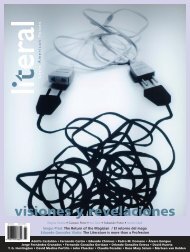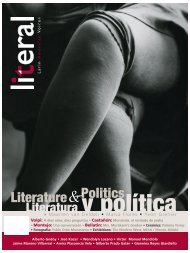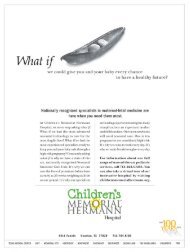Giobany Arévalo > Gabriela Torres Olivares >Anuar Jalife - Literal
Giobany Arévalo > Gabriela Torres Olivares >Anuar Jalife - Literal
Giobany Arévalo > Gabriela Torres Olivares >Anuar Jalife - Literal
You also want an ePaper? Increase the reach of your titles
YUMPU automatically turns print PDFs into web optimized ePapers that Google loves.
It is within this small gap that the reader must<br />
interact with the narrative by fi lling in the details.<br />
Time and space are very elastic between<br />
panels. The distance between panels can<br />
represent a single breath, or it can transport<br />
the reader from the Stone Age in one panel,<br />
to a rocket ship in the next. In my paintings<br />
and collages, I have tried to expand on this<br />
idea, but have never achieved exactly what I<br />
had hoped. By using the medium of comics<br />
to talk about itself, I was able to specifi cally<br />
isolate the gutters. By removing all but the<br />
inner edge of each panel, these pieces limit<br />
the burdens of signifi ers, while still revealing<br />
brief glimpses of what might have been<br />
contained within each panel. The dense layering<br />
of these subjectless grids emphasizes<br />
the fragmented and serial nature of comic<br />
books, without talking about specifi c titles<br />
or characters. I am fascinated by the idea of<br />
dialoguing about the present and future by<br />
referencing the past. With this in mind, this<br />
body of work is used as a platform to highlight<br />
my favorite period in comics, the Golden<br />
and Silver Ages. These are the comics created<br />
between the late Thirties and the early Seventies.<br />
They have an innocence that has been<br />
lost since comic books became big business<br />
in the Seventies and Eighties. During this period<br />
of comic book history, there is a simplicity<br />
and honesty to the storytelling and artwork.<br />
These early writers and artists were trying<br />
to make rent and feed their families one<br />
issue at a time. They had no idea that their<br />
creations would still be thriving today. These<br />
pre-digital works were beautifully printed on<br />
newsprint with only a handful of colors and<br />
techniques, while in the modern industry,<br />
virtually anything is possible. Though based<br />
in comics of the past, the Closure Grids are<br />
commentaries about our contemporary technological<br />
society. Most computer technology,<br />
from your laptop to cable television, is based<br />
in a layered, compartmentalized format. Everywhere<br />
we look, we are bombarded by reproduced<br />
images. The voids in the Closure<br />
pieces represent the rectangular platform for<br />
advertising. This platform is represented by<br />
billboards, magazines, candy wrappers, coffee<br />
cups and just about everything on an iPhone.<br />
This proliferation of reproduced images<br />
is a hallmark of our contemporary society.<br />
RMS: The idea of time is referenced in<br />
this last answer as well as your, studio practices<br />
and in comics themselves. Could you<br />
elaborate in this subject?<br />
CG: The idea of time is one of my biggest<br />
preoccupations, and is an important element<br />
in my work. Man is busier than he has<br />
ever been. We are obsessed with our schedules;<br />
always searching for new methods and<br />
technologies to help us use our time more<br />
effi ciently. Much of this can be attributed to<br />
rapid growth of technology, and the numerous<br />
advancements in travel over the last hundred<br />
years. Time is always short and seemingly<br />
against us.<br />
I reference time several ways in my work.<br />
My titles suggest ideas of time by referring<br />
to the seasons, history, clocks, and periods<br />
in our lifespan. The detailed nature of my<br />
work suggests the countless hours poured<br />
into even the simplest of pieces. The effort<br />
required to digest a complex composition<br />
Closure Grid (ASM #11-21), 2009, collage<br />
makes the viewer aware of their own place<br />
in time. A substantial commitment of time<br />
invested in a work of art is something I have<br />
always admired in the work of others. Time<br />
is also represented in my work through layering.<br />
In a painting or collage, I think about<br />
time in terms of perspective and depth. The<br />
images/layers closest to the viewer’s perspective<br />
are the most recent.<br />
Since comic books are composed entirely<br />
of still-frame moments, the majority of time<br />
transpires between panels. In comics, time is<br />
always now; the current panel being read is<br />
the present, the last panel is the past, and<br />
the next panel will always be the future. This<br />
physical understanding of time is something I<br />
try to embody within my work.<br />
info@literalmagazine.com<br />
To read an article originally written in Spanish, request<br />
your complementary copy at info@literalmagazine.com<br />
Para leer algunos de los artículos escritos en inglés, favor<br />
de pedir la traducción a info@literalmagazine.com<br />
OTOÑO, 2009 LITERAL. VOCES LATINOAMERICANAS 35






